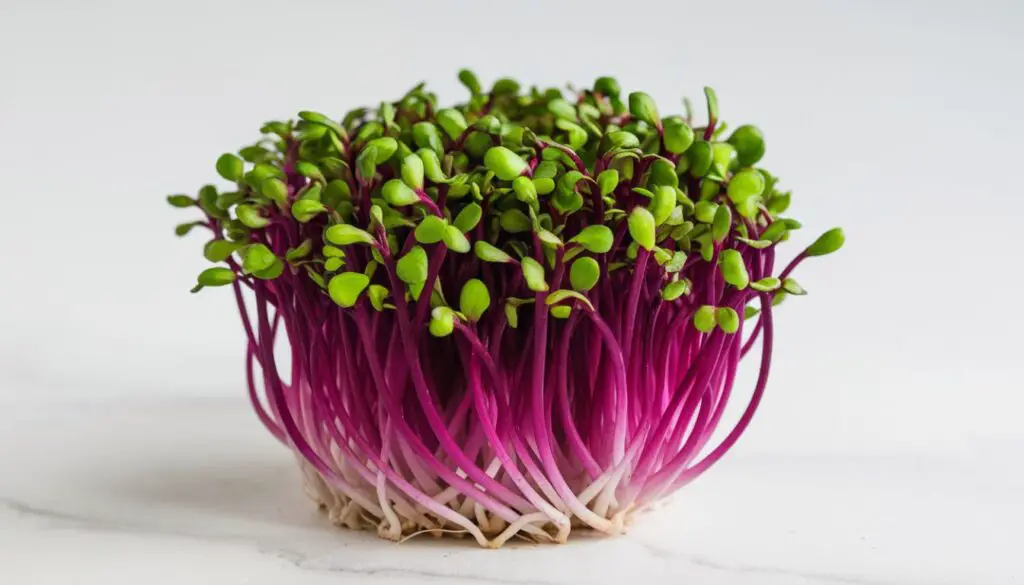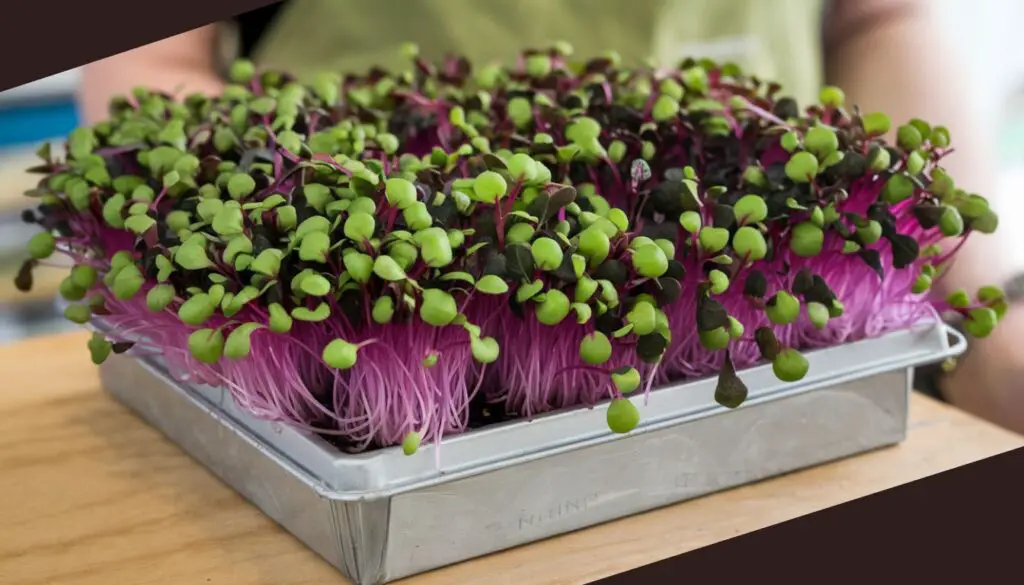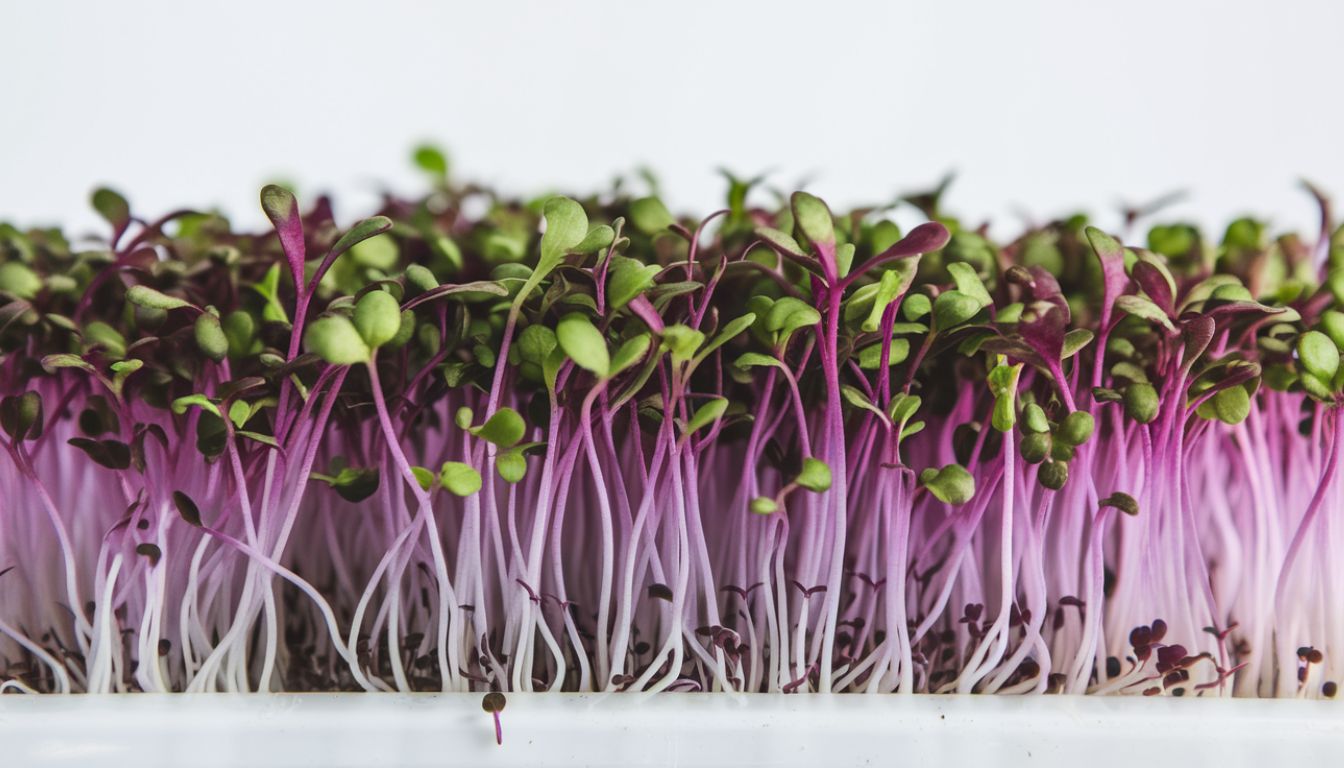Cabbage microgreens are the young seedlings of the cabbage plant, harvested at the cotyledon stage. These microgreens offer the nutritional benefits of mature cabbage but in a smaller, more concentrated form. They are characterized by their tender leaves and rich nutrient content, making them a valuable addition to a balanced diet.
The Appeal of Cabbage Microgreens
Cabbage microgreens are gaining popularity due to their rapid growth cycle, typically ready for harvest within two weeks. This quick turnaround makes them ideal if you are seeking fresh produce without a lengthy wait. Additionally, their vibrant colors and delicate textures enhance the visual appeal of various dishes, making them a favorite among culinary enthusiasts.
Nutrient Profile
These microgreens are rich in essential vitamins and minerals, including vitamins C, K, and E, as well as calcium and iron. They also contain antioxidants and phytochemicals, which play a crucial role in protecting the body from oxidative stress. Consuming cabbage microgreens can contribute significantly to overall health and well-being.
Health Benefits
Cabbage microgreens are particularly beneficial for cardiovascular health. They contain glucosinolates and polyphenols, compounds known to help lower bad cholesterol and triglycerides, thereby reducing the risk of heart disease. Compared to mature cabbage, microgreens offer a more concentrated source of these beneficial nutrients.
Step-by-Step Growing Guide
Getting Started: The Essentials
Growing red cabbage microgreens is like embarking on a delightful little adventure in your kitchen. It’s straightforward, fun, and the rewards are delicious! First things first, you’ll want to gather your supplies. You’ll need high-quality red cabbage seeds. those are the ones I use. Look for organic seeds if you can; they’re like the VIPs of the seed world, ensuring you’re starting with the best.
Next up, grab a shallow tray. This is where the magic will happen. A tray that’s about 1-2 inches deep is perfect because it allows enough room for the roots to grow without overwhelming them. And don’t forget to choose a tray with drainage holes. This will prevent them from sitting in the water and getting soggy.
Soil Selection: The Foundation of Growth
Now, let’s talk about soil. You want a well-draining potting mix that’s rich in organic matter. A good soil mix allows for proper aeration and drainage, which is crucial for healthy root development. If you’re feeling adventurous, you can even mix in some coconut coir or vermiculite to enhance drainage.
Once you have your soil ready, fill the tray about three-quarters full and gently pat it down. No need to compact it too much—your microgreens need room to breathe!
Sowing the Seeds
Here comes the fun part: sowing the seeds! Sprinkle your red cabbage seeds evenly over the surface of the soil. Don’t be shy; give them a little space to spread their leafy wings, but you don’t have to be too precise.
After sowing, gently press the seeds into the soil with your palm or a flat piece of cardboard. This ensures good contact between the seeds and the soil, which is key for germination. Then, mist the surface lightly with water to moisten the soil without drowning the seeds.
The Waiting Game: Light and Moisture
Now that your seeds are snug in their soil bed, it’s time to play the waiting game. Place your tray in a warm spot with plenty of indirect sunlight or under grow lights. Remember, they need about 12 to 16 hours of light each day to thrive. Keep the soil consistently moist but not soggy. A light misting every day or so will do the trick.
Harvesting Your Greens
After about 7 to 14 days, you’ll notice your microgreens starting to sprout. It’s like watching a mini miracle unfold right before your eyes! When they reach about 1 to 3 inches tall and their cotyledons (the first leaves) have fully opened, it’s time to harvest.
Use clean kitchen scissors to snip the greens just above the soil line. Be gentle; you don’t want to disturb the roots too much. And voilà! You’ve successfully grown your own red cabbage microgreens.
Detailed Growing Conditions

Light Requirements
Let’s talk about lighting, the secret sauce to growing vibrant red cabbage microgreens! These microgreens thrive on bright, indirect sunlight, which means you’ll want to find a spot that’s sunny but not too intense.
If you’re lucky enough to have a south-facing window, that’s a prime location. Aim for around 12 to 16 hours of light each day to keep your microgreens happy and healthy. If the sun doesn’t shine quite enough in your home (or if you live in a cave—no judgment here!), consider using grow lights. These artificial lights can mimic the sun’s rays, ensuring your microgreens get the light they need to flourish.
Temperature and Humidity
Now, let’s shift gears and talk about temperature and humidity—two more critical ingredients in the recipe for success. Red cabbage microgreens prefer a cozy environment, ideally between 60°F and 75°F (about 15°C to 24°C). You want that sweet spot where your microgreens feel comfortable enough to sprout and grow without any stress.
Humidity plays a crucial role, too. These little guys love a humid environment, which helps them stay hydrated and healthy. Aim for humidity levels around 40% to 70%. If your home is drier than a desert, consider misting your microgreens with water a couple of times a day. Alternatively, you could place a small tray of water nearby to help increase humidity levels naturally.
Creating the Perfect Environment
So, how do you put all this together for your red cabbage microgreens? Find a sunny spot with plenty of light, keep the temperature just right, and maintain a bit of humidity to create a welcoming atmosphere.
Common Mistakes and Troubleshooting
Growing red cabbage microgreens is generally a walk in the park, but even the best gardeners encounter a few hiccups along the way. Let’s dive into some common issues you might face and how to tackle them like a pro!
Leggy Growth: When Your Greens Stretch for the Stars
First up, let’s talk about leggy growth. You know that feeling when you’re trying to reach the top shelf but can’t quite get there? That’s what it’s like for microgreens that aren’t getting enough light. If your red cabbage microgreens start to look tall and spindly, stretching toward the light like it’s a sign they’re not getting enough brightness.
So, what can you do? If you notice this happening, it’s time to adjust their lighting situation. Move them closer to a bright window or invest in some grow lights. Aim for about 12 to 16 hours of light each day.
Mold Growth: The Unwanted Guest
Now, let’s address the pesky problem of mold. Mold often shows up when there’s too much moisture and not enough airflow.
To prevent this unwelcome visitor, make sure you’re not overwatering your microgreens. A light misting is usually sufficient; you want the soil to be moist but not swimming. If you do spot mold, don’t panic! Simply remove the affected microgreens and improve ventilation. You can use a small fan to circulate air around your growing area, which will help keep things fresh and mold-free.
Yellowing Leaves: A Sign of Trouble
If your microgreens start to develop yellow leaves, it’s like a little red flag waving at you. This could be a sign of several issues, such as nutrient deficiency or improper watering. Remember, these little greens are like delicate divas—they need just the right balance to thrive.
To address yellowing leaves, check your watering routine. Are you giving them too much or too little? Adjusting your watering schedule can often do the trick. If the problem persists, consider using a diluted liquid fertilizer to give your microgreens a nutrient boost.
Pests: Tiny Invaders
Lastly, watch out for tiny pests that might want to crash your microgreen party. Aphids and other little critters can sometimes sneak in, looking to munch on your greens like they’re at an all-you-can-eat buffet. If you notice small bugs or sticky residue on your plants, it’s time to take action.
To keep pests at bay, ensure you’re starting with clean seeds and soil. If you do spot pests, try washing your microgreens gently with water or using a mild insecticidal soap.
Culinary Techniques

So, you’ve successfully grown your red cabbage microgreens—congratulations! Now comes the fun part: incorporating these vibrant little greens into your meals. Think of microgreens as the finishing touch on a gourmet dish, like the cherry on top of a sundae. They’re not just a garnish; they bring flavor, color, and a nutritional punch to your culinary creations. Let’s explore some delightful ways to prepare and use these microgreens in your kitchen!
Garnishing with Style
Microgreens are the perfect way to add that “wow” factor to your plates. Imagine serving a beautiful soup or a hearty sandwich and then topping it off with a handful of fresh red cabbage microgreens.
When garnishing, think about the colors and textures. The vibrant purple hues of red cabbage microgreens can brighten up any meal, making it visually appealing. Just sprinkle them on top of your favorite dishes—soups, salads, or even tacos. They not only enhance the presentation but also add a mild, slightly peppery flavor that complements a variety of foods.
Wrapping It Up
If you’re looking to get a little creative, why not try using microgreens in wraps? Picture this: a whole-grain tortilla filled with hummus, roasted veggies, and a generous handful of red cabbage microgreens. Roll it up, slice it in half, and you’ve got yourself a nutritious, delicious lunch that’s as easy to make as it is to eat.
Microgreens can add a delightful crunch and freshness to wraps and sandwiches. You can mix and match with other ingredients—think avocado, turkey, or even a spicy spread.
Blending into Sauces and Dressings
Now, let’s take it up a notch and talk about blending. Did you know that red cabbage microgreens can be easily incorporated into sauces and dressings? Imagine whipping up a vibrant green pesto or a zesty salad dressing that’s packed with flavor and nutrients.
To make a simple microgreen pesto, blend a handful of red cabbage microgreens with garlic, nuts (like pine nuts or walnuts), olive oil, and Parmesan cheese. Add a squeeze of lemon juice for brightness, and you’ve got a delicious sauce that’s perfect for pasta, sandwiches, or even as a dip for veggies. It’s like giving your classic pesto a colorful twist!
You can also toss microgreens into salad dressings. Just blend them with olive oil, vinegar, a touch of honey, and your favorite herbs for a refreshing dressing that adds a burst of flavor to any salad. It’s an easy way to sneak in some extra greens while keeping your meals exciting.
Before You Go – Red Cabbage Microgreens
Incorporating red cabbage microgreens into your culinary repertoire is not only easy but also incredibly rewarding. Whether you’re garnishing, wrapping, or blending, these tiny greens can elevate your dishes in ways you never imagined. So, roll up your sleeves, get creative in the kitchen, and let your microgreens shine. With their vibrant color and unique flavor, you’ll wonder how you ever cooked without them! Don’t forget to add our website The Herb Prof to your favorites so you don’t miss any future articles. Now keep reading for the FAQs!
References – Red Cabbage Microgreens
Little Herb Encyclopedia, by Jack Ritchason; N.D., Woodland Publishing Incorporated, 1995
The Ultimate Healing System, Course Manual, Copyright 1985, Don Lepore
Planetary Herbology, Michael Tierra, C.A., N.D., Lotus Press, 1988
Handbook of Medicinal Herbs, by James A. Duke, Pub. CRP Second Edition 2007
The Complete Medicinal Herbal, by Penelope Ody, Published by Dorling Kindersley
Check the Following Articles!
Homemade Garlic Salt: The Best You Ever Tried!
Health Benefits of Shiitake Mushrooms
Can You Grow Kale Indoors? All You Need To Know!
African Violet Medicinal Uses: Discover the Healing Power
FAQs – Red Cabbage Microgreens
How long does it take to grow red cabbage microgreens?
Ah, the age-old question of “When can I eat my greens?” The good news is that red cabbage microgreens are quick to sprout! You can expect to see those little green beauties popping up in just about 5 to 10 days. And before you know it, they’ll be ready to harvest in about 7 to 14 days after sowing.
What do I do if my microgreens are growing too slowly?
If your microgreens seem to be taking their sweet time to grow, it might be time for a little detective work. Check their light situation—are they getting enough? Remember, they thrive on bright, indirect sunlight or about 12 to 16 hours of artificial light each day. If they’re not getting their daily dose of sunshine, it’s like trying to grow a plant in a cave—just not going to happen!
Also, consider the temperature. Red cabbage microgreens love a cozy environment, ideally between 60°F and 75°F. If your indoor space is too chilly or too hot, it might be slowing them down.
Can I eat the microgreens raw?
Absolutely! In fact, that’s one of the best ways to enjoy them. Red cabbage microgreens can add a delightful crunch to salads, sandwiches, and wraps. Just remember to wash them gently before eating, as you would with any fresh produce.
How do I store my microgreens after harvesting?
Once you’ve harvested your glorious microgreens, you’ll want to keep them fresh and tasty. The best way to store them is in a breathable container in the fridge. A paper towel-lined container works wonders; it absorbs excess moisture and helps prevent sogginess. They should stay fresh for about a week, but let’s be real—once you taste them, they might not last that long!
Can I grow microgreens indoors?
You bet! In fact, growing microgreens indoors is one of their best features. They don’t need a lot of space, making them perfect for small apartments or kitchens. Just make sure they get enough light and keep an eye on the temperature.
Are there any health benefits to eating red cabbage microgreens?
Oh, absolutely! Red cabbage microgreens are like little powerhouses of nutrition. They’re packed with vitamins C, K, and E, along with antioxidants that help protect your body from free radicals. Plus, they contain glucosinolates, which are known for their potential cancer-fighting properties.

